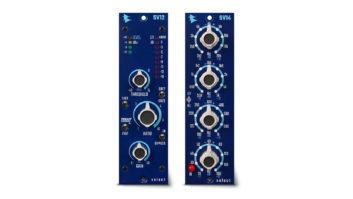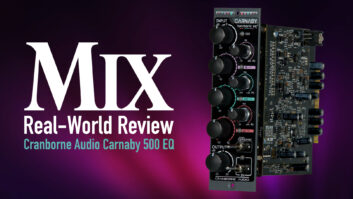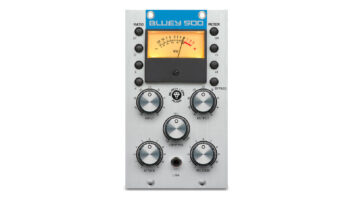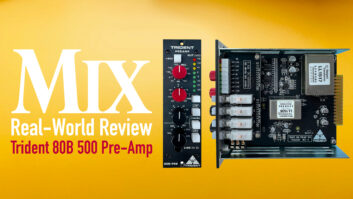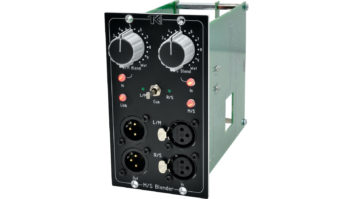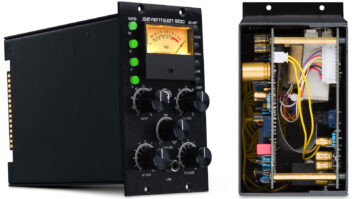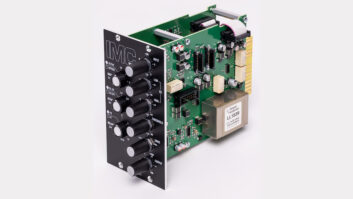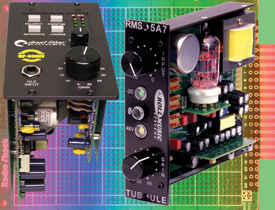
Shown here are two examples of 500 Series modules. On the left, the Great River 500-NV converts the incoming bipolar 16-volts—normally used by API modules—into 24 volts used by Neve-style amplifiers. On the right, the Roll Music Systems RMS 5A7 converts the incoming voltage into tube-capable power—250 volts for the plate and 12 volts for the filament.
No one likes empty spaces and blank faces on an API Lunch Box or 10-space rack. Thanks to a marriage of old and new technology, this month’s column is about clever geeks who have gone beyond the conventional to give the empty real estate in your 500 Series rack an extreme makeover.
In the late ’60s, when Saul Walker founded Automated Processes Inc., recording consoles were client-specific and built around standard in-house modules (such as amplifiers, EQ, etc.) and custom modules (i.e., the monitor section). The same was true for Neve, Putnam, Flickinger and a handful of other manufacturers. Especially in those pre-IC, pre-transformerless days, each console had a signature sound, and that was before the built-in EQ and compression were switched in. Back then, API modules found their way into many non-API consoles, such as DeMedio and Sony, but I don’t think Walker ever envisioned that so many third-party entrepreneurs would embrace his 15-pin edge-connector configuration and make their own products for it. (Log on to mixonline.com to see a few of those companies.)
To a D.I.Y. enthusiast, the beauty of the 500 Series format is that the mechanics and power supply are already done — a huge savings because items like these, as well as metalwork and I/O, can add up to a big expense. And while building a power supply is hardly a major technical issue, making it legal — adding a seal of approval from Underwriter’s Labs, CSA (Canada) and CE (Europe) — is complex and expensive. Using the existing power supply allows more time for product development. This is one reasons many products use “wall-wart”-style power supplies.
Feels Like Latin
The beauty of a dead language — or an outdated operating system and software — is the lack of change, and after a tweak to accommodate phantom power, the 500 Series edge connector pinout was etched in stone. As shown in the table above, plus and minus 16 volts are respectively supplied to pins 12 and 14, with ground on pin 13 and 48V on pin 15. An API 525 module has three 2520 op amps and consumes 80 mA — an important consideration/target because 10 modules in a rack want to be within 75 percent of the power supply’s rating. (According to Justin Morse of Roll Music Systems, the limit is 130 mA per slot.)
Inside the typical 500 Series power supply are two regulators: an LM-317 (positive) and an LM-337 (negative). When properly heat-sinked and ventilated, these devices are good for up to 1.5 amps, 75 percent of which is 1.125 amps (another safety margin target). For these devices to run cool, it should be noted that the input/output voltage differential should be conservative — within 12 volts (according to the maximum spec) and preferably under 10 volts. If the regulator’s output is 16 volts, then the input to the regulator shouldn’t be more than 26 volts — and even that is pushing it a bit. Higher local line voltages (what comes out of the wall) can produce higher regulator input voltages, thus exacerbating thermal issues, especially when the rack is fully populated.
New Classes in the Hood
You might think a co-op power review board might rule out a 24-volt, single-ended Class-A amplifier from moving into a bipolar 16-volt hood. Similarly, a classic RCA-style tube preamp couldn’t possibly be squeezed into a 500 Series module, let alone run on the available power, right? But that didn’t stop two local audio geeks from trying (and succeeding).
Dan Kennedy of Great River Electronics and Justin Morse of Roll Music Systems independently chose similar paths when designing their 500 Series modules. Their goal was to deliver the same performance and specs without compromise. Kennedy solved his power challenge by using a TDK-Lambda DC-to-DC power converter module that accepts anything from 18 to 36V and outputs bipolar 12 volts (24 total), which is exactly what classic Neve amplifiers want.
Putting a vacuum tube in Roll Music Systems’ RMS5A presented two power challenges. The vacuum tube requires a high plate voltage (250V) along with enough current for the 12V filament (150mA). Morse chose an off-the-shelf DC-to-DC converter for the filament and a voltage multiplier for the plate. Both are vertically mounted on a separate PCB to conserve space.
With power management out of the way, the next challenge was physical: squeezing a Great River ME-1NV (half of an MP-2NV) into what became the MP-500NV. To comfortably fit two large British transformers required a doublewide 500 Series module. By contrast, the RMS5A7 output transformer matches tube to line-level impedance at a much higher ratio than its solid-state counterpart, which surely contributed to a smaller transformer. To further conserve real estate, the tube preamp does not include a DI or metering.
Morse also did not go for the typical 12A?7 dual-triode options, but decided on a 12DW7/ECC832/7247 available as NOS or new from JJ Electronic. This is a dual triode with the same pinout as a 12A?7, but with a twist: One triode section is equivalent to a 12AX7 (high gain) while the other is like a 12AU7, with lower output impedance and 10x the current capability, making it better suited for driving a load.
D.I.Y. Starter Kit
In addition to seeing both modules’ internals, the background of the opening graphic also shows a pre-fab project board that started out with 44 pins, but was hacked down to 15. Thus equipped, you’re on the way to creating a little 500 Series module of your own. But before embarking on your project, it’s a good idea to do what API did: Use a pair of diodes on the module’s power input to block accidental reverse polarity. Include three LEDs to confirm the presence of power, and you’re ready to roll your own 500 Series module.
Visit Eddie at
tangible-technology.com.
AUDIO SCIENCE
DC-TO-DC CONVERTERS
The beauty of this type of converter is that it behaves like an active power transformer, in that voltage conversion has an inverse effect on current, where the power (watts = amps times volts, or P = IE) is the same on both the primary and the secondary. If a transformer secondary delivers 24 volts to a 1-amp load after rectification, the power is 24 watts. The power reflected on the primary side is also 1W. We know the voltage is 120, so by using P = IE, 24 = “I” × 120 so that I (the current in amps) = 200 milliwatts (mW).
A conventional linear power supply relies on the 60Hz power line frequency, which is not the most efficient way to transfer power from primary to secondary. A DC-to-DC converter works its magic at superhigh frequencies via internal oscillator, allowing far greater efficiency from a much smaller transformer. Technically, it’s win-win.
— Eddie Ciletti

